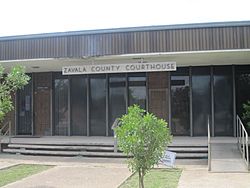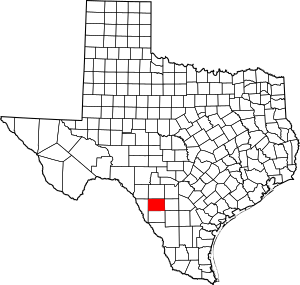Zavala County, Texas facts for kids
Quick facts for kids
Zavala County
|
|
|---|---|

Zavala County Courthouse in Crystal City
|
|

Location within the U.S. state of Texas
|
|
 Texas's location within the U.S. |
|
| Country | |
| State | |
| Founded | 1884 |
| Named for | Lorenzo de Zavala |
| Seat | Crystal City |
| Largest city | Crystal City |
| Area | |
| • Total | 1,302 sq mi (3,370 km2) |
| • Land | 1,297 sq mi (3,360 km2) |
| • Water | 4.3 sq mi (11 km2) 0.3% |
| Population
(2020)
|
|
| • Total | 9,670 |
| • Density | 7.427/sq mi (2.8676/km2) |
| Time zone | UTC−6 (Central) |
| • Summer (DST) | UTC−5 (CDT) |
| Congressional district | 23rd |
Zavala County is a county in the state of Texas. In 2020, about 9,670 people lived there. Its main town, or county seat, is Crystal City. The county was created in 1858 and officially started in 1884. It is named after Lorenzo de Zavala. He was a Mexican politician who signed the Texas Declaration of Independence. He was also the first vice president of the Republic of Texas.
Contents
History
Early People
Scientists have found that the Tortuga Flat Site in Zavala County was used by the Pacuache people in the 1400s and 1500s. An archeologist named T. C. Hill found many old tools and items there in the 1970s. Researchers from the University of Texas at San Antonio have found over 100 other old sites on the Chaparrosa Ranch. After the Pacuache, other groups like the Coahuiltecan, Tonkawa, Lipan Apache, Mescalero Apache, and Comanche lived in the area.
The Wild Horse Desert
The land between the Rio Grande and the Nueces River, which included Zavala County, was once a disputed area. It was called the Wild Horse Desert. Neither the Republic of Texas nor the Mexican government fully controlled it. This changed after the Mexican–American War. For a while, the area had many lawless people, which made it hard for settlers to move in.
How the County Grew
Zavala County was officially formed in 1858. It was named after Lorenzo de Zavala, a Mexican colonist who helped Texas become independent. When the county was first set up, there was a spelling mistake, an extra "L" in the name. This mistake was not fixed until 1929.
At first, Batesville was the county seat. But in 1928, Crystal City was chosen to be the new county seat. Some of the first families to settle in the area were the White and Vivian families around 1867. The Ramón Sánchez and Galván families joined them in 1870.
Ranching was the main activity in the county for a long time. But too many animals eating the grass ruined the land. So, Zavala became the first county in Texas to grow flax, a plant used to make cloth, for money. Ike T. La Pryor, who owned a very large ranch, encouraged people to farm the land. The town that grew there was named La Pryor. In 1905, two developers bought a huge ranch and created the town of Crystal City. They also sold the rest of the land in smaller farms.
The Winter Garden Area
Zavala, Dimmitt, Frio, and LaSalle Counties are known as the Winter Garden region of Texas. Because of good irrigation and mild winters, this area is perfect for growing vegetables all year.
Spinach was first grown in Zavala County in 1917. The first annual Spinach Festival was held in 1936. It stopped during World War II but started again in 1982. E. C. Segar, the cartoonist who created Popeye, the spinach-eating sailor, received a thank-you letter from the Winter Garden Chamber of Commerce. He had helped make spinach popular! Segar even approved a statue of Popeye in Crystal City in 1937. It was dedicated "To All The Children of the World." Other important crops grown in the county include Bermuda onions, sorghum, cotton, pecans, and corn.
Internment Camp during WWII
During World War II, the Crystal City Family Internment Camp was set up in Zavala County. It started as a camp for migrant workers in the 1930s. During the war, it held families of German and Japanese people. This included people from Latin America, and German- and Japanese-American families.
The camp was about 100 acres (40 hectares) for housing and security. Another 190 acres (77 hectares) were used for farming and staff homes. The first people held there, who were German, arrived in December 1942. They were expected to help with construction. A hospital and a school for children were built in 1943. The people held in the camp also ran their own nursery schools and kindergartens. By June 1945, the camp had held 4,751 people. There were also 153 babies born there. The camp closed in 1948.
Hispanic Americans
The Mexican Revolution began in 1910. This led to many workers crossing the border into Texas to help grow vegetables. By 1930, most people in Crystal City were Hispanic Americans. In 1990, about 89.4% of the county's population was Hispanic.
Geography
Zavala County covers about 1,302 square miles (3,372 square kilometers). Most of this is land, with a small amount of water.
Main Roads
Neighboring Counties
- Uvalde County (to the north)
- Frio County (to the east)
- Dimmit County (to the south)
- Maverick County (to the west)
- La Salle County (to the southeast)
People Living in Zavala County
| Historical population | |||
|---|---|---|---|
| Census | Pop. | %± | |
| 1860 | 26 | — | |
| 1870 | 138 | 430.8% | |
| 1880 | 410 | 197.1% | |
| 1890 | 1,097 | 167.6% | |
| 1900 | 792 | −27.8% | |
| 1910 | 1,889 | 138.5% | |
| 1920 | 3,108 | 64.5% | |
| 1930 | 10,349 | 233.0% | |
| 1940 | 11,603 | 12.1% | |
| 1950 | 11,201 | −3.5% | |
| 1960 | 12,696 | 13.3% | |
| 1970 | 11,370 | −10.4% | |
| 1980 | 11,666 | 2.6% | |
| 1990 | 12,162 | 4.3% | |
| 2000 | 11,600 | −4.6% | |
| 2010 | 11,677 | 0.7% | |
| 2020 | 9,670 | −17.2% | |
| U.S. Decennial Census 1850–2010 2010 |
|||
| Race / Ethnicity (NH = Not Hispanic) | Pop 2000 | Pop 2010 | Pop 2020 | % 2000 | % 2010 | % 2020 |
|---|---|---|---|---|---|---|
| White alone (NH) | 924 | 647 | 572 | 7.97% | 5.54% | 5.92% |
| Black or African American alone (NH) | 43 | 35 | 67 | 0.37% | 0.30% | 0.69% |
| Native American or Alaska Native alone (NH) | 17 | 9 | 21 | 0.22% | 0.08% | 0.22% |
| Asian alone (NH) | 8 | 3 | 19 | 0.07% | 0.03% | 0.20% |
| Pacific Islander alone (NH) | 1 | 3 | 1 | 0.01% | 0.03% | 0.01% |
| Other race alone (NH) | 1 | 3 | 3 | 0.01% | 0.03% | 0.03% |
| Mixed race or Multiracial alone (NH) | 24 | 16 | 43 | 0.21% | 0.14% | 0.44% |
| Hispanic or Latino | 10,582 | 10,961 | 8,944 | 91.22% | 93.87% | 92.49% |
| Total | 11,600 | 11,677 | 9,670 | 100.00% | 100.00% | 100.00% |
In 2020, there were 9,670 people living in Zavala County. About 3,674 households and 3,039 families lived there.
In 2000, there were 11,600 people. About 91.22% of the people were Hispanic or Latino. About 43.80% of households had children under 18. The average household had 3.28 people. The average family had 3.70 people.
The median age in the county was 29 years old. This means half the people were younger than 29 and half were older. For every 100 females, there were about 97.5 males.
The median income for a household was $16,844. For a family, it was $19,418. This means Zavala County is one of the poorest counties in the United States.
Towns and Places
City
- Crystal City (This is the county seat, the main town)
Other Places
These are places where many people live, but they are not officially cities:
Education
Children in Zavala County go to schools in these districts:
- Crystal City Independent School District
- La Pryor Independent School District
- Uvalde Consolidated Independent School District
For college, students can attend Southwest Texas Junior College.
See also
 In Spanish: Condado de Zavala para niños
In Spanish: Condado de Zavala para niños


